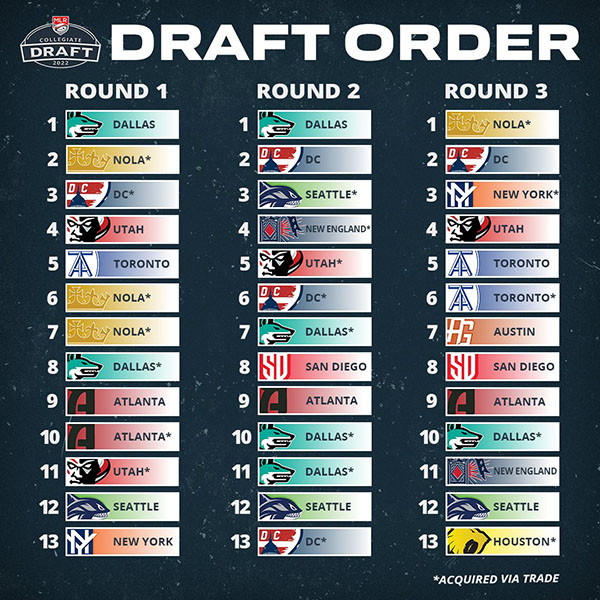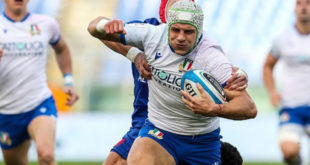The third edition of the Major League Rugby Collegiate Draft is just two days away. As in previous years, the draft itself will take place in advance with video airing the day after its completion. 12 teams will take part, with the exception being LA who have already traded their three picks.
For a third consecutive year it’s Dallas who have the first overall selection. Their 2020 picks would end up being re-dispersed after the Jackals opted to postpone their league entry by a year. In 2021 they had five picks, and ended the season with seven players from that class after making trades.
This year Dallas will call out the names of seven players, two more than next-highest DC. NOLA hold three of the top seven picks in the draft including the 2nd overall selection. The Gold are one of four teams with four picks including ATL, Seattle, and Utah. MLR champions New York have two picks, while each of Austin and Houston won’t get to select anyone until the third round.
FORMAT
There are no changes to the format in terms of rounds and selections awarded, however the process of determining the draft order itself was changed. Whereas previously it was reverse order of finish in the regular season, this time the order takes into account post-season finishes. A complete explainer of the revised process can be seen here.
Several trades contributed to alterations in the picking order. Two recent changes came in deals involving NOLA. The Gold sent the 18th overall selection to Utah in exchange for winger James Vaifale, and then acquired the 2nd overall pick from Old Glory in exchange for the 3rd and 26th overall picks.
The order as it stands is as follows:

ELIGIBILITY
Players are required to declare their entry to the draft. They are then posted on the Draft Prospects page of the MLR website. This year saw 174 names put their name forward for selection, slightly up from last year’s 168 though it should be noted some names like Rudy Scholz Award nominees George Phelan and Riley Kerr were late withdrawals.
In order to declare players must have played rugby during the 2021-2022 academic year and have either completed three years of college or be at least 21 years old. Athletes from both US and Canadian schools are able to enter the draft.
Those who declare and are not returning to school become free agents. Players who are eligible but opt to skip the draft will have to miss the entire 2023 season before being allowed to play. That’s a reversal of the mid-season rule that was instituted last season, though MLR notes they may grant an exception on a case-by-case basis.
It’s a change that was likely precipitated by Austin’s signing of St. Mary’s duo Payton Telea-Ilalio and Ronan Murphy. Both would have been top choices had they opted in, with Telea-Ilalio possibly a first-overall choice. Instead they bypassed the draft and joined the AGs half-way through the 2022 season.
There are certainly some collegiate stars missing from this year’s group. Cal flyhalf Sam Walsh is not on the list and Central Washington center Jack Wendling has already joined the Eagles Sevens program. Three of Canada’s towering Carson family would have been among the top picks – locks Donald and Frank from UBC and No8 Nick from Victoria. It remains to be seen if any turn to MLR in the future.
THE PROSPECTS
FRONT ROW
One name stands out as most capable of making an immediate impact. Former Canada u20 prop Cali Martinez, who is also US-eligible, is older than the other contenders at 25 and has been a star for the UBC Thunderbirds. He is a destructive scrummager who can play both sides, though his shorter stature makes him more likely to play on the loosehead side at the pro level. Lindenwood’s Gabe Kettering is a physical specimen who will be eyed by many, while USA u23 select Doyle Hedgepeth is an interesting athlete who recently converted from center.
On the tighthead side Central Washington’s Ivan Pula has already played for the USA Selects and is likely at the top of the list. He can also operate at loosehead as he did in Montevideo. Kutztown’s Trent Rogers and Brandon Karnes from Iowa State have both played for USA age-grade sides, while Denver Fatt from the University of Victoria is a solid customer in both the tight and the loose.
At hooker the two names at the top of the list are Jack Manzo and KoiKoi Nelligan. Cal’s Manzo is unquestionably the best player at his position and recently captained USA u23, though he is on the smaller side. Nelligan starred with the national champion Army West Point side. He has a lot of potential though having played largely at flanker in college it will take time to adjust to the set piece.
SECOND/BACK ROW
Normally we would separate the locks and the loosies but once again the cupboard is quite bare when it comes to genuine second row prospects. The age-grade internationals are Kutztown’s Matt Gelhaus, Lindenwood’s Bill Whiteside, and UVic’s Ben Newhook. All stand around 6’5″ (1.96m) which while decent for college rugby is fairly ordinary in MLR.
Then there is the a group of players who played lock in college but project as back row players in MLR. Of those Cal captain and Rudy Scholz finalist Sam Golla is rated the highest and for good reason. At 6’4″ (1.93m) he could be an exceptional blindside flanker with hard-hitting defense, strong ball carrying, and lineout prowess. Chase Jones from St. Mary’s is about the same height and has played for the USA u20 side. Army’s Collin Grosse and Lindenwood’s Marnus Spangenberg are both about an inch shorter. Spangenberg was a Rudy Scholz nominee but the Australian is the lightest of the bunch and won’t hit the five-year residency mark until mid-2023.
UBC captain Owain Ruttan might be the best pure flanker available. The Canada u20 international can play either side and has a tireless work rate. John DuPree played all over the pack for Central Washington but projects as a hard-nosed openside. At the back of the scrum it’s two imports who are the most dynamic ball carriers. Tomás Casares from Argentina showed some of his bruising attributes in the Collegiate Rugby Shield, while Mark Mutuku from Notre Dame College is a Kenya u20 rep and has been included in senior Simbas training squads.
HALFBACKS
Perhaps no player improved their stock more than St. Bonaventure’s Sebastiano Villani at the Shield match in Utah. The Italian scrumhalf is US-eligible and has both speed off the mark and strong core skills. Lindenwood’s Evan Conlon, a USA u23 select, and NCR D1 All-American Tai Kauwe from Kutztown also featured in that match. Ex-Canada u20 rep Tony Pomroy is the oldest player in the draft at 27 and recently played for the Atlantic Selects in the Coast-to-Coast Cup.
At flyhalf the top two names are UCLA’s Shane Barry and Dartmouth’s Mike Weir. Barry is the younger brother of Dallas scrumhalf Cian and played for the USA Selects in Uruguay last fall. Weir has played at every age-grade level for the USA up to u23s. Both are a little lightweight but have excellent skills at a position where domestic talent is highly prized. Chandler Owens from Kansas has an impressive left boot, while Kutztown’s South African kicker Thorne O’Connell was a Collegiate All-American and Thomas More’s Matías Caramuti, another Argentine, showed an array of footballing skills in Herriman.
MIDFIELD
First on the list in the midfield could well be Canadian age-grade rep Seth Purdey, who has spent the past five years with the Cal Golden Bears. He can play either midfield slot and has sharp distribution skills with enough size to compete at the next level. UVic’s Gabe Casey and Bishop’s Jack Shaw have also played for Canada u20, while UBC’s Connor Byron made the national u19s. Casey has good size and the versatility to cover flyhalf and fullback.
GCU’s Royce Fisher is a USA u20 select who can step his way through tight spaces. A pair of Zimbabweans could be wildcards. Wheeling’s Michael Muleya is a punishing defender with good size who can also play fullback. Mazvita Nyamarebvu from Arkansas State has all the attributes to be a standout inside center.
OUTSIDE BACKS
There are three Canadian options who all stand around 6’2″ (1.88m) available. UVic’s Ethan Hager and Ottawa’s James Flemming both represented their country at the University (FISU) World Cup, while Guelph’s Jack Morris is currently on the roster for the Pacific Pride.
American options could be UCLA’s Mark Sapper, Arizona State’s Devin Rivet, and Sam Williams from Adrian College. Sapper has excellent upper body strength while the diminutive Rivet is an out-and-out gas man. Williams looks to have good rugby IQ and can play across the back three.
Jeff Mutuku, brother of Mark, is the only player available who is already capped at senior international level. He made his test debut for Kenya against Uganda in 2019. Miles Dycaico played both rugby and soccer for Boston University and has obvious kicking skills to go with a unique stepping style.
WHO GOES FIRST?
With the first pick in the 2022 MLR draft, the Dallas Jackals select…
The odds-on favorite has to be Sam Golla, who is as close to a sure-thing selection as it gets. Dallas, however, already have some fine young American back row players and might instead look towards Shane Barry, with his brother already on the roster and a UCLA connection in Eric Naposki. If they want the best prop, Cali Martinez fits the bill. We’ll find out soon enough.
HOW TO WATCH
The draft will be broadcast on Thursday evening starting at 4pm Pacific, 7pm Eastern. Those in the USA can watch the first hour on Fox Sports 2, with coverage then switching to The Rugby Network. Those located outside the USA can watch the entirety of proceedings on The Rugby Network.
 Americas Rugby News Rugby news from across the Americas!
Americas Rugby News Rugby news from across the Americas!




